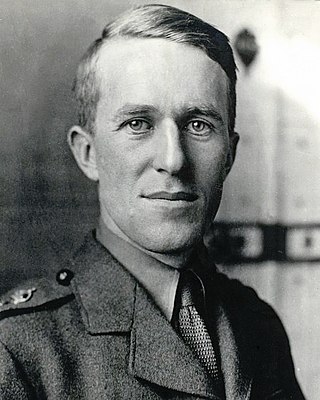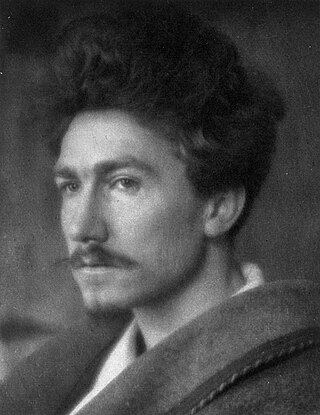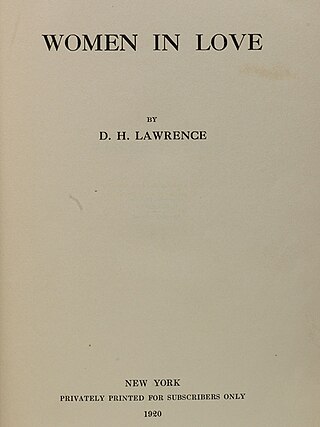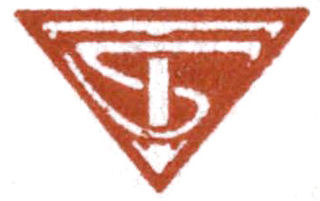
Death of a Hero is a World War I novel by Richard Aldington. It was his first novel, published by Chatto & Windus in 1929, and thought to be partly autobiographical.

Thomas Edward Lawrence was a British archaeologist, army officer, diplomat, and writer who became renowned for his role in the Arab Revolt (1916–1918) and the Sinai and Palestine Campaign (1915–1918) against the Ottoman Empire during the First World War. The breadth and variety of his activities and associations, and his ability to describe them vividly in writing, earned him international fame as Lawrence of Arabia, a title used for the 1962 film based on his wartime activities.

David Herbert Lawrence was an English novelist, short story writer, poet, playwright, literary critic, travel writer, essayist, and painter. His modernist works reflect on modernity, social alienation and industrialization, while championing sexuality, vitality and instinct. Several of his novels, Sons and Lovers, The Rainbow, Women in Love, and Lady Chatterley's Lover, were the subject of censorship trials for their radical portrayals of sexuality and use of explicit language.

Richard Arthur Warren Hughes was a British writer of poems, short stories, novels and plays.

Richard Aldington was an English writer and poet. He was an early associate of the Imagist movement. His 50-year writing career covered poetry, novels, criticism and biography. He edited The Egoist, a literary journal, and wrote for The Times Literary Supplement, Vogue, The Criterion, and Poetry. His biography, Wellington (1946), won him the James Tait Black Memorial Prize.

Aaron's rod refers to any of the walking sticks carried by Moses' brother, Aaron, in the Torah. The Bible tells how, along with Moses's rod, Aaron's rod was endowed with miraculous power during the Plagues of Egypt that preceded the Exodus. Later, his rod miraculously sprouted blossoms and almonds to symbolize God's choice of Aaron and his tribe for holy service.

Imagism was a movement in early-20th-century poetry that favored precision of imagery and clear, sharp language. It is considered to be the first organized modernist literary movement in the English language. Imagism has been termed "a succession of creative moments" rather than a continuous or sustained period of development. The French academic René Taupin remarked that "it is more accurate to consider Imagism not as a doctrine, nor even as a poetic school, but as the association of a few poets who were for a certain time in agreement on a small number of important principles".

Raymond Henry Williams was a Welsh socialist writer, academic, novelist and critic influential within the New Left and in wider culture. His writings on politics, culture, the media and literature contributed to the Marxist critique of culture and the arts. Some 750,000 copies of his books were sold in UK editions alone, and there are many translations available. His work laid foundations for the field of cultural studies and cultural materialism.

Lady Chatterley's Lover is the last novel by English author D. H. Lawrence, which was first published privately in 1928, in Italy, and in 1929, in France. An unexpurgated edition was not published openly in the United Kingdom until 1960, when it was the subject of a watershed obscenity trial against the publisher Penguin Books, which won the case and quickly sold three million copies. The book was also banned for obscenity in the United States, Canada, Australia, India and Japan. The book soon became notorious for its story of the physical relationship between a working-class man and an upper-class woman, its explicit descriptions of sex and its use of then-unprintable profane words. It entered the public domain in the United States in 2024.

Women in Love (1920) is a novel by English author D. H. Lawrence. It is a sequel to his earlier novel The Rainbow (1915) and follows the continuing loves and lives of the Brangwen sisters, Gudrun and Ursula. Gudrun Brangwen, an artist, pursues a destructive relationship with Gerald Crich, an industrialist. Lawrence contrasts this pair with the love that develops between Ursula Brangwen and Rupert Birkin, an alienated intellectual who articulates many opinions associated with the author. The emotional relationships thus established are given further depth and tension by an intense psychological and physical attraction between Gerald and Rupert.

John Middleton Murry was an English writer. He was a prolific author, producing more than 60 books and thousands of essays and reviews on literature, social issues, politics, and religion during his lifetime. A prominent critic, Murry is best remembered for his association with Katherine Mansfield, whom he married in 1918 as her second husband, for his friendship with D. H. Lawrence and T. S. Eliot, and for his friendship with Frieda Lawrence. Following Mansfield's death, Murry edited her work.

George Norman Douglas was a British writer, now best known for his 1917 novel South Wind. His travel books, such as Old Calabria (1915), were also appreciated for the quality of their writing.

The Plumed Serpent is a 1926 political novel by D. H. Lawrence; Lawrence conceived the idea for the novel while visiting Mexico in 1923, and its themes reflect his experiences there. The novel was first published by Martin Secker's firm in the United Kingdom and Alfred A. Knopf in the United States; an early draft was published as Quetzalcoatl by Black Swan Books in 1995. The novel's plot concerns Kate Leslie, an Irish tourist who visits Mexico after the Mexican Revolution. She encounters Don Cipriano, a Mexican general who supports a religious movement, the Men of Quetzalcoatl, founded by his friend Don Ramón Carrasco. Within this movement, Cipriano is identified with Huitzilopochtli and Ramón with Quetzalcoatl. Kate eventually agrees to marry Cipriano, while the Men of Quetzalcoatl, with the help of a new president, bring about an end to Christianity in Mexico, replacing it with pagan Quetzalcoatl worship.

Traditionally, the canon of Sherlock Holmes consists of the 56 short stories and four novels written by Sir Arthur Conan Doyle. In this context, the term "canon" is an attempt to distinguish between Doyle's original works and subsequent works by other authors using the same characters. Usually capitalized by aficionados of the Sherlockian game as "the Canon", the description of these 60 adventures as the Sherlock Holmes canon and the game of applying the methods of "Higher Criticism" to it was started by Ronald Knox as a playful use of the traditional definition of canon as an authoritative list of books accepted as holy scripture.

The Story of the Treasure Seekers is a novel by E. Nesbit first published in 1899. It tells the story of Dora, Oswald, Dicky, Alice, Noel, and Horace Octavius Bastable, and their attempts to assist their widowed father and recover the fortunes of their family. The novel's complete name is The Story of the Treasure Seekers: Being the Adventures of the Bastable Children in Search of a Fortune. The original edition included illustrations by H. R. Millar. The Puffin edition (1958) was illustrated by Cecil Leslie. Its sequels are The Wouldbegoods (1901) and The New Treasure Seekers (1904).
This is a list of works by the English writer Anthony Burgess.

Panic Spring is a novel by Lawrence Durrell, published in 1937 by Faber and Faber in Britain and Covici-Friede in the United States under the pseudonym Charles Norden. It is set on a fictional Greek Island, Mavrodaphne, in the Ionian Sea somewhere between Patras, Kephalonia, and Ithaca. The island, however, resembles Corfu strongly, and in at least one inscribed copy of the novel, Durrell includes a map of Corfu identified as Mavrodaphne.

Thomas Seltzer was a Russian-American translator, editor and book publisher.

Giuseppe "Pino" Orioli (1884–1942) was a Florentine bookseller best known for privately publishing the unexpurgated first edition of Lady Chatterley's Lover and for his long association with Norman Douglas.
Maurice Magnus was an American traveller and author of Memoirs of the Foreign Legion (1924), which exposed the cruelty and depravity of life in that French army unit in 1916–17 and tells of his desertion from it. The book is known for D. H. Lawrence's 80-page introduction to it. Magnus and Lawrence knew each other from November 1919 to May 1920.


















